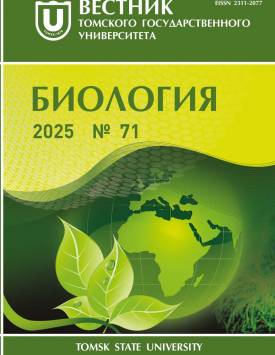Natural revegetation of the 20-year-old “Chernogorsky” spoil dump in the Republic of Khakassia
The natural complexes of the Republic of Khakassia are in the process of anthropogenic transformation as a result of large-scale mining. The volume of anthropogenic pollution can be reduced by forming a vegetation cover on the slopes of spoil dumps, therefore studying the aspects of the formation of plant communities on spoil dumps is of actual importance. The fundamental side of the study is to investigate the problems of plants adaptation to new industry caused environmental factors. The applied side is to develop and improve reclamation technologies for disturbed areas. The purpose of the research is to study the structure and productivity of plant communities on 20-year-old open cut spoil dumps with the aim to estimate processes of natural revegetation of the disturbed lands in the arid zones of the Republic of Khakassia. The objects of the research are formed in the 1990’s plant communities on the floor and slopes of different exposures of the “Chernogorsky” open cut spoil dumps (53°44'42"N, 91°02'27"E) by LLC SUEK-Khakassia. The climate of the research area is sharply continental with a cold long winter (the absolute minimum temperature is -40.6°С) and a hot dry summer (the absolute maximum is +35.6°С), while the average annual precipitation is from 270 to 300 mm per year. The composition of the rocks covering the coal seams of the “Chernogorsky” deposit includes sandstones, siltstones, and carbonaceous mudstones, which, in turn, are overlain by a cover of quaternary deposits. Geobotanical zoning relates the area of the “Chernogorsky” open cut to Near-Abakan (Central Khakassian) district of the Minusinsk basin. Bunch-grass steppes, in the typical form of the four-grass steppe distinguished by V.V. Reverdatto, are the most prevalent for this area. Collection of materials on the “Chernogorsky” open cut was conducted in July-August from 2008 to 2012 according to conventional techniques. To examine the species composition, herbarium material was collected and geobotanical description was carried out. To determine the aboveground phytomass productivity and the economically significant botanical groups composition, mowing and species separation was carried out yearly, fourfold in July-beginning of August. To establish the above-ground phytomass vertical structure the standing parts were cut down to the roots, then cut in layers 0-10, 1020, 20-30 cm, etc., and then weighed as fresh mass. Underground phytomass productivity was determined in 2009 by threefold sampling 10 cm3 soil monoliths in layers 0-10 and 10-20 cm. Roots were rinsed, then dried and weighed. The species distribution evenness was estimated using species dominance graphs. The dumps are of external method of formation. On all mesorelief elements (northern, southern, western, eastern slopes, and the floor), primary successions have a grass type of vegetation. The species composition is depleted and includes 42 species of vascular plants from 36 genera and 20 families, which is 11.7% of the Khakassian stony steppe flora. The most numerous families are Asteraceae and Poaceae, which is vastly typical for boreal flora. The peculiarity of the flora of the bunch-grass steppes of the Republic of Khakassia (which existed on the research area prior to mines) is the wide presence of endemic species of the near-Yenisei steppes, with legumes and Poaceae as dominating families amongst endemics. The absence of those endemics is observed in the species composition of plant communities on spoil dumps. The prevailing economic groups of plants are Poaceae and motley grasses (See Fig. 1). The dominants in the plant communities are synanthropic grasses: Artemisia sieversiana Willd., Salsola collina Pall., Erysimum cheiranthoides L., Chenopodium aristatum L. etc. Dominating Poaceae species are Calamagrostis epigeios L., Leymus racemosus (Trin.) K. Richt., Elytrigia repens L., Agropyron cristatum (L.) Gaertner. The dominant in legumes is faintly eaten Melilotus officinalis L. The plant communities on spoil dump contain a significant part (61.9%) of mesophytic group, which is usually observed in the meadow steppes. Considering life forms, a large part of vegetation is vegetative plants (which roam the surface of the dump and germinate in new places without retaining the habitat area). This contrasts the steppe zonal communities, where prevailing species are of the restative type (capable of living through unfavorable conditions and “resisting” the seizure of their area by other individuals). The vertical structure of spoil dumps plant communities was revealed, which show the herbage to have significant height and be enclosed mostly in a layer 0-40 cm (See Fig. 2). The productivity of above-ground phytomass is higher on spoil dumps than that (0.53-1.59 t/ha) in zonal communities: maximal productivities of airdry phytomass are observed on the floor (2.1 ± 0.7 t/ha) and the northern slope (2.6 ± 0.2 t/ha) due to better microclimatic conditions (See Table 2). The above-ground phytomass prevails over the underground one on all areas of spoil dumps, which indicates the environmental conditions to be generally favorable for plants growth. The significance graphs show the lognormal distribution to be typical for the plant communities on all mesorelief elements, which is characteristic for multispecies zonal plant communities with predominance of species with an average abundance (See Fig. 3). Thus, 20-year-old natural vegetation on spoil dumps of “Chernogorsky” open cut in the arid regions of the Republic of Khakassia prove to be at an intermediate stage of restoration (primary succession), and it differs in composition and structure from the indigenous steppe community. The article contains 4 Figures, 2 Tables, 37 References. The Authors declare no conflict of interest.
Keywords
vegetable cover, mesorelief, overburden, natural overgrowth, succession, productivityAuthors
| Name | Organization | |
| Sheremet Natalia V. | Central Siberian Botanical Garden, Siberian Branch of the RAS | nsheremet@yandex.ru |
| Safronova Olga S. | Research Institute of Agricultural Problems of Khakassia, FRC KSC SB RAS | olya_egoshina@mai.ru |
| Lamanova Tatyana G. | Central Siberian Botanical Garden, Siberian Branch of the RAS | tlamanova@yandex.ru |
References

Natural revegetation of the 20-year-old “Chernogorsky” spoil dump in the Republic of Khakassia | Vestnik Tomskogo gosudarstvennogo universiteta. Biologiya - Tomsk State University Journal of Biology. 2025. № 71. DOI: 10.17223/19988591/71/5
